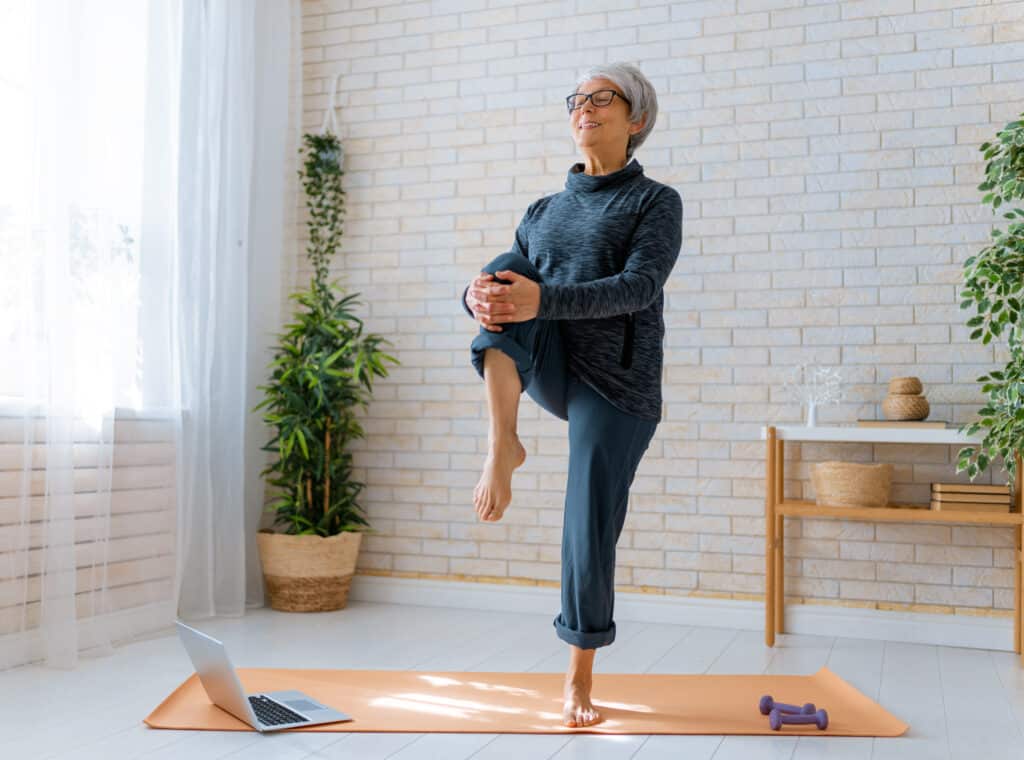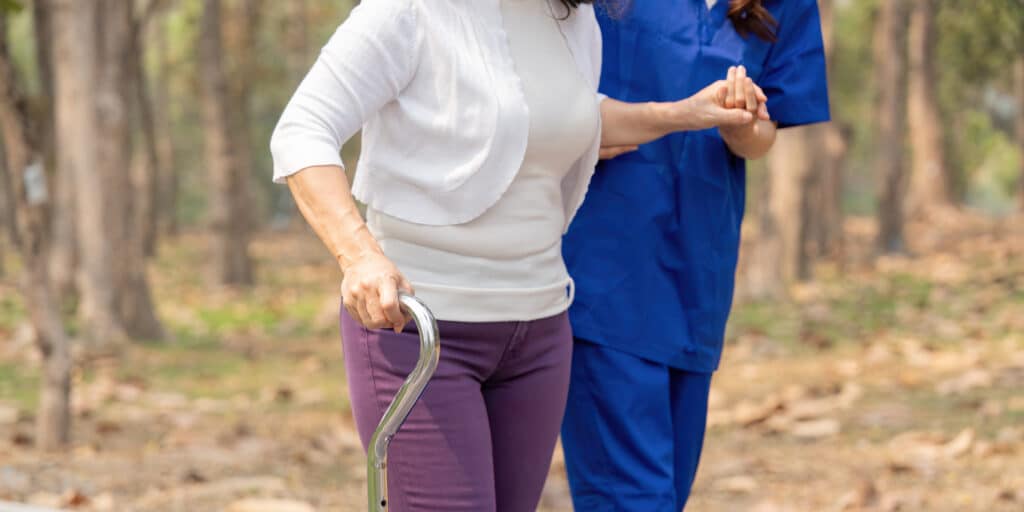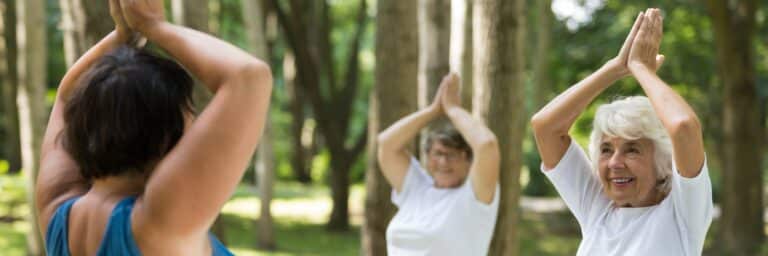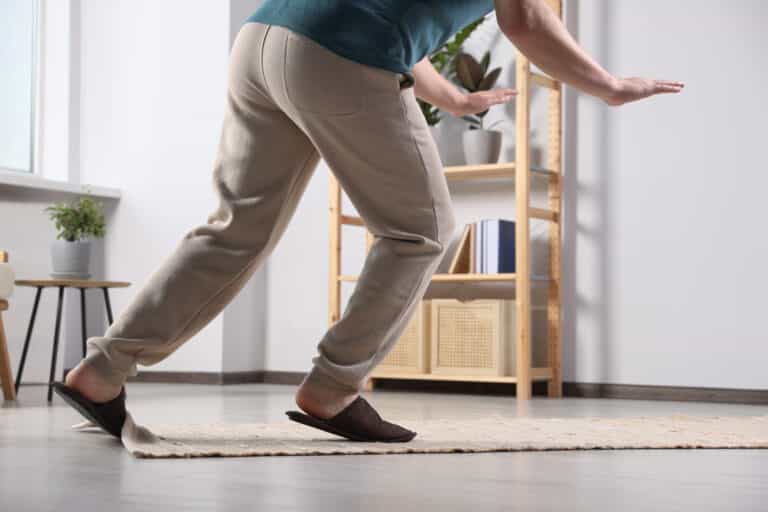Maintaining good balance is crucial for staying safe and independent, but unsteadiness can creep in over time, making falls more likely. Knowing how to do a balance test at home can help you identify any issues early and take action to improve your stability.
In this article, we’ll guide you through simple, effective balance tests — many of which you can perform yourself — offering insights into why balance changes and what you can do to stay steady.
Whether you’re concerned about your balance or just want to be proactive, this piece will provide valuable tips to help you maintain confidence in your movements.
How Aging Impacts Your Balance Systems

Good balance relies on three key systems: your inner ear, vision, and sense of touch. These systems work together to keep you steady when walking, standing, or moving through different environments.
The Inner Ear (Vestibular System)
This system detects motion and head position changes, sending signals to your brain to help you stay balanced.
As you age, natural neuron loss can reduce the effectiveness of this system, making it harder to maintain your balance, especially in challenging situations.
Vision (Ocular System)
Your eyes provide crucial visual information to help you navigate your surroundings and adjust to changes.
Vision can deteriorate with age due to conditions like macular degeneration, cataracts, or glaucoma, leading to blurry vision or decreased depth perception. These changes force your brain to rely more on other balance systems, which may not be as sharp.
Sense of Touch (Somatosensory System)
The term proprioception refers to your body’s ability to understand your posture and balance position.
The sense of touch, especially in your feet and legs, helps your brain understand your body’s position in space. This feedback is essential for adjusting your posture and maintaining stability.
However, factors like injuries, surgeries, or neuropathy can reduce proprioception, making it harder to stay balanced.
These systems constantly interact with one another, but their contributions can shift depending on your environment.
For instance, walking in a dark room requires your brain to rely more on your inner ear and sense of touch since your vision is less effective. As these systems age, they may not work as seamlessly, increasing the risk of falls.
Understanding how these systems work and how they change with age empowers you to take proactive steps to maintain balance.
The Hidden Dangers of Ignoring Your Balance

Unaddressed balance issues can lead to serious consequences for seniors, with falling being the primary concern.
Falls are the leading cause of head injuries among older adults and frequently result in other severe injuries, such as broken bones.
According to the Centers for Disease Control, 20% of older adults who fall experience a serious injury, including fractures. Alarming statistics also reveal that 95% of hip fractures are caused by falls.2
Many falls are directly linked to balance problems, but the good news is that they can often be prevented. Simple balance testing and regular exercises can be crucial in maintaining stability and preventing injuries.
Fall Risk & Common Causes of Balance Loss
There are several causes of balance loss. To illustrate the dangers of poor balance, let’s examine one of the main consequences of poor balance: fall risk.
Fall Risk and Tripping Hazards
Tripping over objects or obstacles while walking is a common result of poor balance. These trips or stumbles often result from vision changes, such as poor depth perception, a simple lack of attention, or a decline in coordination.
Loss of balance can stem from various factors, many of which are manageable with the right approach. All of these tripping hazard issues can be linked to the natural cognitive decline that comes with aging.
Common Causes of Fall Due to Sudden Loss of Balance
Poor reflexes or ability to stabilize after a trip are common causes of falls.
Quick reflexes are crucial when recovering from a trip. If your ability to step quickly and regain balance is diminished, the likelihood of falling increases significantly.
Dizziness is another common culprit behind balance problems. It can result from changes in the vestibular system or a balance disorder, but it may also be triggered by dehydration, low blood sugar, low blood pressure, or even heart conditions.
One of the most common forms of dizziness related to the inner ear is benign paroxysmal positional vertigo (BPPV), which causes a spinning sensation, particularly when you move your head.
If you experience new or worsening dizziness, it’s essential to discuss it with your doctor to pinpoint the cause and determine the best course of treatment.
Understanding your strengths and weaknesses in balance can empower you to take proactive steps to safeguard your health. By identifying areas of concern, you can make necessary modifications to reduce your risk of falls and stay safer at home.
In the following sections, we’ll explore some easy at-home tests to help you assess your balance and take control of your well-being.
Balance Testing at Home
Testing your balance at home is a simple and effective way to assess your stability and identify areas for improvement. By performing a few easy exercises, you can gain valuable insight into your balance and take proactive steps to prevent falls and maintain independence.
Before you begin, ensure you’re positioned near a sturdy surface, like a countertop, for support if needed. These tests target different aspects of your balance and provide a comprehensive snapshot of your overall stability.
If you need assistance with these tests, consult your doctor or a physical therapist for guidance on improving your balance safely.
Let’s start with the simplest balance test: standing on one leg.
Single Leg Balancing
Simple though it may seem, standing on one leg can be an easy way to determine whether your balance needs some work.
How to do the test
- Stand near your stable surface for safety and lift one leg off the floor.
- Try to maintain balance for as long as possible, using your hand for balance as little as necessary.
- This exercise can be done on both legs, and you can try making it more challenging by closing one or both eyes, as long as you feel confident and safe.
The Rhomberg Test
Another simple test uses the “Rhomberg position,” which involves standing up straight with your feet together and your arms crossed over your chest.
How to do the test
- Stand with your feet together near your stable surface and cross your arms over your chest.
- Hold this position for sixty seconds, standing as still as possible.
- If this feels relatively easy, you can try the next progression, which is the same position but with your eyes closed.
This can be further progressed to the sharpened Rhomberg test:
Instead of standing with your feet together, you will stand with one foot in front of the other so your heel touches the opposite toes like you’re standing on a balance beam.
Both tests require you to stand as still as possible without holding onto a support surface or moving your feet.
Passing this test means standing relatively still in the position for sixty seconds.
Failing the test refers to moving your feet, touching the countertop, or catching your balance in these positions.3
The Five-Time Sit-to-Stand Test
This test addresses your safety level with “transfers,” or the ability to get up and down from a chair. It requires both balance and strength in your lower legs.
For this test, you will need a standard-height chair (such as a dining room chair) and a stopwatch.
How to do the test
- Start by sitting in the chair with your arms crossed over your chest.
- Try to stand up and sit back down five times in a row.
- If this feels relatively easy, you can try the next progression, which is the same position but with your eyes closed.
- The goal is to do this as fast as you can. Have someone start the timer as soon as you begin to stand during the first repetition and stop the timer when you are sitting after the fifth repetition.
If you cannot complete this test or it takes more than fifteen seconds, you are considered at higher risk of falling. If so, consider talking to your healthcare provider.4
The Functional Reach Test
This test checks your ability to keep your balance when reaching forward.
For the functional reach test, you will need something to measure with, such as a meter stick or measuring tape. It may be helpful to have someone nearby to help you measure.
How to do the test
- You will start standing with your feet at a comfortable distance and your arm straight out in front of you.
- Try to stand up and sit back down five times in a row.
- Reach forward as far as you can without taking a step or losing your balance.
- Mark the furthest-reaching position
Any noticeable difficulty, inability, or imbalance with reaching beyond seven inches indicates you are at a higher risk of falling, and a professional screen may be a good idea.5
Balance Testing by a Professional
If you find the home balance assessments challenging or if you have concerns about your balance, it’s a good idea to follow up with a medical provider, such as a physical therapist, for a more thorough evaluation.
Physical therapists specialize in assessing and treating various balance disorders and can comprehensively analyze your stability.
What to Expect
During your visit, the physical therapist will likely repeat some of the tests you tried at home to observe your balance and identify areas where you may be struggling.
In addition, they may conduct more advanced assessments that evaluate both static (still) and dynamic (moving) balance to gain a deeper understanding of your capabilities.
These tests might involve movements like turning, closing your eyes, or standing on different surfaces to evaluate how well your balance systems work together and where improvements might be needed.
Clinical Test of Sensory Interaction on Balance (CTSIB Test)
The CTSIB test assesses static balance and how well your eyes and inner ear (vestibular system) work together to help you maintain stability. This test can reveal how effectively your brain processes information about your body’s position in space.
What to Expect from This Test
- The test begins with two positions identical to the Rhomberg test: standing still with your feet together, first with your eyes open and then with your eyes closed.
- Next, you’ll repeat the same test twice on a soft foam surface with eyes open and closed. The foam surface makes it harder for your body to use proprioceptive feedback, challenging your balance.
In some clinics, the test may include two additional positions using a specialized dome to obstruct your vision, adding a visual “conflict” to the challenge. In these cases, you will be asked to balance with your eyes open and feet together, both on and off the foam.
Given the complexity of this test, you’ll typically hold each position for thirty seconds instead of the usual sixty. Each condition is repeated three times to ensure accurate results.6
Timed Up & Go (TUG Test)
The Timed Up & Go test is one of the most common functional balance tests because it requires minimal equipment and time to complete.
What to Expect from This Test
- This test requires you to stand from a chair, walk three meters, turn around, and return to sitting in the same chair while timed.
- The goal is to do this test as quickly as you can safely. A time of more than 13.5 seconds would indicate a higher risk of falls.
Completing the Timed Up & Go test within the recommended time frame is a strong indicator of good balance and lower fall risk.7
Balance Evaluation Systems Test (Mini-BEST Test)
The Mini-BEST test is a comprehensive assessment that includes fourteen movements designed to evaluate different aspects of your balance. It measures static balance, walking balance, transfers, balance on varied surfaces, and your ability to react to balance challenges.
One advantage of this test is that it incorporates many elements from other balance assessments, providing a thorough evaluation.
Each of the fourteen items is scored on a scale of 0 to 2 based on your performance, with a maximum possible score of 28. A score below 19 indicates a higher risk of falls.8
Achieving a higher score on the Mini-BEST test suggests better overall balance and a reduced risk of falls.
The video above shows one of the tests as a brief example of one of the movements. Since this test needs to be scored by a medical professional, it is best to discuss the Mini-BEST test with your physical therapist.
Balance Test Results & Next Steps
Further training will likely be recommended if your home balance assessments or physical therapist’s tests reveal difficulties.
A physical therapist can design a personalized program to address your specific balance needs and help you improve.
Even if your results were satisfactory, staying proactive is key to maintaining optimal balance as you age. Regular movement and activity are essential.
Consider joining balance training classes at your local community center or gym, or explore activities like yoga or Tai Chi, which are excellent for enhancing balance and spatial awareness.
Because balance involves multiple systems and areas of the brain, it is important to engage in exercises that work the entire body.
Consult your physical therapist to determine the most appropriate exercises for you to keep your balance strong and stable.
Key Takeaways
- As you age, your balance may gradually become less steady, making it essential to be aware of your balance system and areas where you may be unsteady
- Understanding how the human balance system works and how to test or improve it can help prevent falls and maintain good balance as you get older
- Good balance relies on three key systems: the inner ear, vision, and sense of touch
- These systems work together to keep you steady, but aging can affect each one, increasing your fall risk
- Common causes of balance loss include tripping due to vision changes, cognitive decline, or dizziness from various conditions
- Ignoring balance issues can lead to falls, which are the leading cause of head injuries and broken bones among older adults
- Home balance tests like standing on one leg, the Rhomberg Test, the Five-Time Sit-to-Stand Test, and the Functional Reach Test can help assess your stability
- If these tests are challenging, consulting a physical therapist for professional evaluation and targeted balance exercises is wise
- Staying proactive with regular movement, balance training classes, or exercises like yoga or Tai Chi can help maintain optimal balance as you age
FAQs
How can I test my balance at home?
You can test your balance at home using simple exercises like standing on one leg, the Rhomberg test, or the five-time sit-to-stand test. These exercises help assess your stability and identify areas where you may need improvement.
What are the signs that I need to improve my balance?
Signs you need to improve your balance include frequent stumbling, difficulty walking on uneven surfaces, dizziness, and a lack of coordination when moving or turning. If you notice these issues, taking steps to enhance your balance is essential.
What is the easiest balance test to perform at home?
The easiest balance test to perform at home is standing on one leg. Simply lift one foot off the ground while using a sturdy surface for support if needed. This test quickly reveals any balance weaknesses you may have.
How can I improve my balance after testing at home?
After testing your balance at home, you can improve it through targeted exercises such as leg lifts, heel-to-toe walks, and strengthening routines. Incorporating balance training into your daily routine, like practicing yoga or Tai Chi, can also help.
Why is it important to do a balance test at home regularly?
Regular balance tests at home are important because they help you monitor your stability and catch any issues early. By being proactive, you can prevent falls, maintain independence, and stay active daily.
References
- Remaud, A., Thuong-Cong, C., & Bilodeau, M. (2016). Age-Related Changes in Dynamic Postural Control and Attentional Demands are Minimally Affected by Local Muscle Fatigue. Frontiers in aging neuroscience, 7, 257. https://doi.org/10.3389/fnagi.2015.00257
- Centers for Disease Control and Prevention. Facts About Falls. https://www.cdc.gov/falls/facts.html
- Forbes J, Munakomi S, Cronovich H. Romberg Test. [Updated 2022 Nov 2]. In: StatPearls [Internet]. Treasure Island (FL): StatPearls Publishing; 2022 Jan-. Available from: https://www.ncbi.nlm.nih.gov/books/NBK563187/
- Shirely Ryan Ability Lab. June 2013. https://www.sralab.org/rehabilitation-measures/five-times-sit-stand-test
- Shirley Ryan Ability Lab. Functional Reach Test. December 2013. https://www.sralab.org/rehabilitation-measures/functional-reach-test-modified-functional-reach-test
- Shirley Ryan Ability Lab. Clinical Test of Sensory Interactions on Balance. November 2013. https://www.sralab.org/rehabilitation-measures/clinical-test-sensory-interaction-balance#:~:text=The%20CTSIB%20was%20developed%20as,patient’s%20attempt%20to%20maintain%20balance.
- Shirley Ryan Ability Lab. Timed Up and Go. November 2013. https://www.sralab.org/rehabilitation-measures/timed-and-go
- Shirley Ryan Ability Lab. Balance Evaluation Systems Test. August 2018. https://www.sralab.org/rehabilitation-measures/balance-evaluation-systems-test






